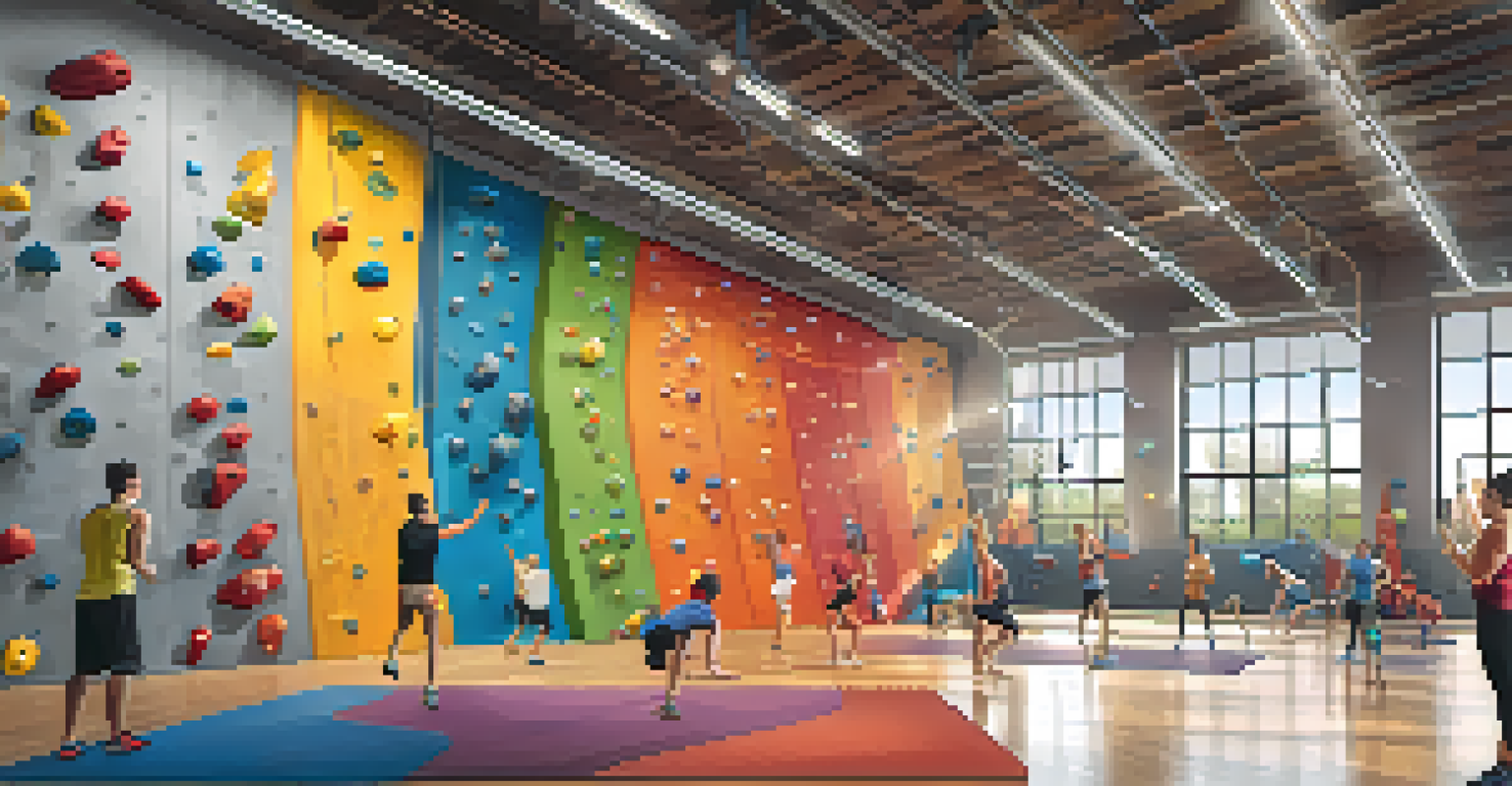The Importance of Warm-Up Routines for Indoor Climbers

Understanding the Basics of Warm-Up Routines
Warm-up routines are essential for any physical activity, especially for indoor climbers. They prepare your body for the demands of climbing by gradually increasing your heart rate and blood flow to your muscles. This process helps to reduce the risk of injury, ensuring that you can climb safely and effectively.
The more you sweat in training, the less you bleed in combat.
A good warm-up typically involves dynamic stretching and movements that mimic the activity you'll be doing. For climbers, this might include arm circles, leg swings, and gentle climbing drills. The goal here is to increase mobility and flexibility, which are crucial for reaching those challenging holds on the wall.
Incorporating a well-structured warm-up into your climbing routine can significantly enhance your performance. You'll find that your body feels more agile and ready to tackle those tough routes, making your climbing sessions more enjoyable and productive.
The Physical Benefits of Warming Up
Warming up is not just about getting your heart pumping; it also prepares your muscles and joints for the demands of climbing. By increasing your body temperature, you enhance the elasticity of your muscles and tendons, allowing for better range of motion. This flexibility is crucial when you're reaching for that next hold or executing a tricky move.

Moreover, warming up helps to activate your nervous system, improving coordination and reaction times. This is particularly important in climbing, where every movement counts, and quick adjustments can make or break your ascent. A proper warm-up ensures that your body responds effectively to the challenges ahead.
Warming Up Reduces Injury Risk
A proper warm-up routine prepares your body and minimizes the chances of injuries while climbing.
Finally, warming up can help prevent injuries such as strains and sprains, which are common among climbers. By taking the time to warm up, you're investing in your long-term climbing health and performance. It’s a small effort that pays off significantly during your climbs.
Mental Preparation Through Warm-Up Routines
While the physical benefits of warming up are clear, the mental aspect is equally important. A well-structured warm-up routine can help you shift your focus from the outside world to your climbing goals. This mental transition is vital for climbing, where concentration and confidence are key to success.
By failing to prepare, you are preparing to fail.
Taking time to warm up allows you to visualize your climbing routes and plan your strategies. By mentally rehearsing your moves during the warm-up, you set yourself up for a more successful climb. It’s akin to an athlete visualizing their performance before a big game; this practice can lead to improved results.
Additionally, warming up can help ease any pre-climb anxiety or nerves. The repetitive nature of warm-up exercises can have a calming effect, grounding you before you take on the vertical challenges ahead. This mental clarity can make a noticeable difference in your climbing performance.
Incorporating Dynamic Stretching into Your Routine
Dynamic stretching is an excellent way to enhance your warm-up routine, especially for climbers. Unlike static stretching, which involves holding a position, dynamic stretches involve movement, promoting blood flow and muscle activation. Examples include walking lunges, arm swings, and torso twists, all of which mimic the motions you'll use while climbing.
These stretches not only improve flexibility but also engage your core and stabilize your muscles, which are crucial during climbs. By incorporating dynamic stretching, you prepare your body for the specific movements and demands of climbing, reducing the likelihood of injury.
Dynamic Stretching Enhances Performance
Incorporating dynamic stretches into your warm-up can improve flexibility and muscle activation for climbing.
Consider dedicating the first 10-15 minutes of your climbing session to dynamic stretching. You'll find that your body feels more prepared and responsive as you tackle each route, leading to a more enjoyable and successful climbing experience.
Specific Warm-Up Exercises for Climbers
To maximize the benefits of your warm-up, it's essential to include exercises that target the muscles used in climbing. Start with some light cardio, such as jogging or jumping jacks, to get your heart rate up. Then, move on to specific exercises like finger rolls, wrist stretches, and shoulder mobility drills, which are crucial for grip strength and upper body performance.
In addition to these exercises, consider incorporating climbing-specific movements, such as traversing the wall at a low intensity. This allows your body to adapt to the climbing motion and engage the muscle groups you'll be using during your climbs. It’s a practical way to warm up while also getting a feel for the climbing surface.
Remember, the goal of these specific warm-up exercises is to prepare your body for the unique challenges of climbing. By focusing on the areas you’ll be engaging, you’ll enhance your performance and decrease the risk of potential injuries.
Common Mistakes to Avoid During Warm-Ups
While warm-ups are crucial, many climbers make common mistakes that can hinder their effectiveness. One of the biggest pitfalls is rushing through the warm-up or skipping it altogether. Climbing without a proper warm-up can lead to injuries and decreased performance, so it's essential to prioritize this step in your routine.
Another mistake is focusing too much on static stretches, which can actually decrease muscle performance if done before climbing. Instead, opt for dynamic movements that prepare your muscles for action. Remember, the goal is to get your body ready for the specific demands of climbing, not just to stretch.
Personalized Routines Boost Confidence
Creating a tailored warm-up routine can enhance both your physical readiness and mental focus for climbing.
Lastly, don’t forget to listen to your body during your warm-up. If you feel tightness or discomfort, take extra time to address those areas. Each climber’s body is different, and what works for one person may not work for another. Tailoring your warm-up to your specific needs can make a significant difference in your climbing experience.
Creating a Personalized Warm-Up Routine
Every climber is unique, and so should be your warm-up routine. Start by assessing your own body and identifying which areas feel tight or require extra attention. This self-awareness will help you create a warm-up that targets your specific needs, ensuring you’re adequately prepared for your climbs.
Consider including a variety of exercises that address both your physical and mental preparation. Mixing dynamic stretches, climbing-specific movements, and breathing exercises can create a well-rounded routine. Just like a recipe, you can adjust the ingredients based on your preferences and what works best for you.

Don’t hesitate to experiment with different routines until you find one that feels right. Over time, you’ll discover what helps you feel the most prepared, confident, and ready to tackle your climbing goals. A personalized warm-up routine can enhance not just your performance but also your overall climbing experience.